#distribution line sensor
Explore tagged Tumblr posts
Text
100 Inventions by Women
LIFE-SAVING/MEDICAL/GLOBAL IMPACT:
Artificial Heart Valve – Nina Starr Braunwald
Stem Cell Isolation from Bone Marrow – Ann Tsukamoto
Chemotherapy Drug Research – Gertrude Elion
Antifungal Antibiotic (Nystatin) – Rachel Fuller Brown & Elizabeth Lee Hazen
Apgar Score (Newborn Health Assessment) – Virginia Apgar
Vaccination Distribution Logistics – Sara Josephine Baker
Hand-Held Laser Device for Cataracts – Patricia Bath
Portable Life-Saving Heart Monitor – Dr. Helen Brooke Taussig
Medical Mask Design – Ellen Ochoa
Dental Filling Techniques – Lucy Hobbs Taylor
Radiation Treatment Research – Cécile Vogt
Ultrasound Advancements – Denise Grey
Biodegradable Sanitary Pads – Arunachalam Muruganantham (with women-led testing teams)
First Computer Algorithm – Ada Lovelace
COBOL Programming Language – Grace Hopper
Computer Compiler – Grace Hopper
FORTRAN/FORUMAC Language Development – Jean E. Sammet
Caller ID and Call Waiting – Dr. Shirley Ann Jackson
Voice over Internet Protocol (VoIP) – Marian Croak
Wireless Transmission Technology – Hedy Lamarr
Polaroid Camera Chemistry / Digital Projection Optics – Edith Clarke
Jet Propulsion Systems Work – Yvonne Brill
Infrared Astronomy Tech – Nancy Roman
Astronomical Data Archiving – Henrietta Swan Leavitt
Nuclear Physics Research Tools – Chien-Shiung Wu
Protein Folding Software – Eleanor Dodson
Global Network for Earthquake Detection – Inge Lehmann
Earthquake Resistant Structures – Edith Clarke
Water Distillation Device – Maria Telkes
Portable Water Filtration Devices – Theresa Dankovich
Solar Thermal Storage System – Maria Telkes
Solar-Powered House – Mária Telkes
Solar Cooker Advancements – Barbara Kerr
Microbiome Research – Maria Gloria Dominguez-Bello
Marine Navigation System – Ida Hyde
Anti-Malarial Drug Work – Tu Youyou
Digital Payment Security Algorithms – Radia Perlman
Wireless Transmitters for Aviation – Harriet Quimby
Contributions to Touchscreen Tech – Dr. Annette V. Simmonds
Robotic Surgery Systems – Paula Hammond
Battery-Powered Baby Stroller – Ann Moore
Smart Textile Sensor Fabric – Leah Buechley
Voice-Activated Devices – Kimberly Bryant
Artificial Limb Enhancements – Aimee Mullins
Crash Test Dummies for Women – Astrid Linder
Shark Repellent – Julia Child
3D Illusionary Display Tech – Valerie Thomas
Biodegradable Plastics – Julia F. Carney
Ink Chemistry for Inkjet Printers – Margaret Wu
Computerised Telephone Switching – Erna Hoover
Word Processor Innovations – Evelyn Berezin
Braille Printer Software – Carol Shaw
⸻
HOUSEHOLD & SAFETY INNOVATIONS:
Home Security System – Marie Van Brittan Brown
Fire Escape – Anna Connelly
Life Raft – Maria Beasley
Windshield Wiper – Mary Anderson
Car Heater – Margaret Wilcox
Toilet Paper Holder – Mary Beatrice Davidson Kenner
Foot-Pedal Trash Can – Lillian Moller Gilbreth
Retractable Dog Leash – Mary A. Delaney
Disposable Diaper Cover – Marion Donovan
Disposable Glove Design – Kathryn Croft
Ice Cream Maker – Nancy Johnson
Electric Refrigerator Improvements – Florence Parpart
Fold-Out Bed – Sarah E. Goode
Flat-Bottomed Paper Bag Machine – Margaret Knight
Square-Bottomed Paper Bag – Margaret Knight
Street-Cleaning Machine – Florence Parpart
Improved Ironing Board – Sarah Boone
Underwater Telescope – Sarah Mather
Clothes Wringer – Ellene Alice Bailey
Coffee Filter – Melitta Bentz
Scotchgard (Fabric Protector) – Patsy Sherman
Liquid Paper (Correction Fluid) – Bette Nesmith Graham
Leak-Proof Diapers – Valerie Hunter Gordon
FOOD/CONVENIENCE/CULTURAL IMPACT:
Chocolate Chip Cookie – Ruth Graves Wakefield
Monopoly (The Landlord’s Game) – Elizabeth Magie
Snugli Baby Carrier – Ann Moore
Barrel-Style Curling Iron – Theora Stephens
Natural Hair Product Line – Madame C.J. Walker
Virtual Reality Journalism – Nonny de la Peña
Digital Camera Sensor Contributions – Edith Clarke
Textile Color Processing – Beulah Henry
Ice Cream Freezer – Nancy Johnson
Spray-On Skin (ReCell) – Fiona Wood
Langmuir-Blodgett Film – Katharine Burr Blodgett
Fish & Marine Signal Flares – Martha Coston
Windshield Washer System – Charlotte Bridgwood
Smart Clothing / Sensor Integration – Leah Buechley
Fibre Optic Pressure Sensors – Mary Lou Jepsen
#women#inventions#technology#world#history#invented#creations#healthcare#home#education#science#feminism#feminist
46 notes
·
View notes
Text
Low Voltage Relays Explained: Types, Functions, and Applications
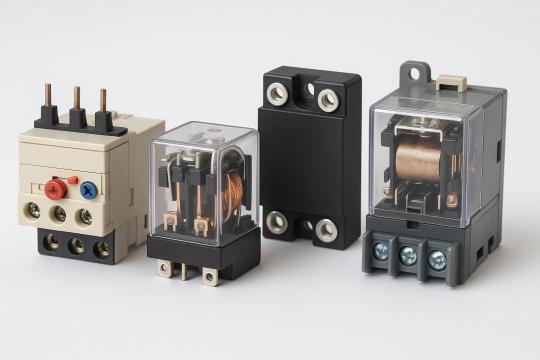
In the complex world of electrical systems, relays play a crucial role in ensuring safety, efficiency, and automation. Among these, low voltage relays stand out as versatile components that manage and protect circuits operating below 1000 volts. Whether in industrial automation, residential power distribution, or commercial infrastructure, these devices act as the nerve center of electrical control and protection.
In this comprehensive guide, we will break down what low voltage relays are, explore their types, explain their functions, and highlight their diverse applications across industries.
What Are Low Voltage Relays?
A low voltage relay is an electrically operated switch that uses a small control voltage (typically below 1000V AC or DC) to switch larger electrical loads on and off. These relays act as intermediaries between control circuits and power circuits, providing isolation, control, and protection.
Unlike manual switches, relays automate the process of circuit management, responding to electrical signals, fault conditions, or system commands without human intervention.
Types of Low Voltage Relays
Low voltage relays come in several forms, each tailored to specific tasks within an electrical system. Here are the main types:
1. Electromechanical Relays (EMRs)
· Use a coil and a movable armature to open or close contacts.
· Provide physical isolation between input and output.
· Common in traditional control panels and basic automation.
2. Solid-State Relays (SSRs)
· Use semiconductors (like thyristors or triacs) instead of mechanical contacts.
· Offer silent operation, faster switching, and longer lifespan.
· Ideal for high-speed applications and environments requiring low maintenance.
3. Overload Relays
· Specifically designed to protect motors and equipment from sustained overcurrent.
· Available as thermal overload relays (using bimetallic strips) or electronic overload relays (using sensors and processors).
4. Time Delay Relays
Provide a deliberate time lag between the relay receiving a signal and switching.
Used in motor control circuits, lighting systems, and sequential operations.
5. Overcurrent and Short-Circuit Relays
· Detect and react to current exceeding preset thresholds.
· Essential for system protection against faults and overloads.
6. Voltage Monitoring Relays
· Monitor voltage levels and trip when voltages fall below or rise above safe limits.
· Protect sensitive devices from under voltage and overvoltage conditions.
Functions of Low Voltage Relays
Low voltage relays serve multiple vital functions in electrical systems:
1. Switching and Control
Relays control the opening and closing of power circuits in response to low voltage signals from controllers, timers, or sensors. This enables remote and automated control of large electrical loads.
2. Protection
Relays detect abnormal conditions like overloads, overcurrent, under voltage, and phase failures. When such conditions arise, they disconnect the affected circuit to prevent equipment damage or fire hazards.
3. Isolation
They electrically isolate control circuits (usually low voltage, low current) from power circuits (high voltage, high current), ensuring safety and reducing interference.
4. Signal Amplification
A small control signal (from a PLC, sensor, or microcontroller) can trigger a relay to switch much larger loads, effectively amplifying the control power.
5. Automation and Sequencing
In complex systems, relays help sequence operations by ensuring that processes occur in the correct order and at the right time intervals.
Applications of Low Voltage Relays
Low voltage relays are the backbone of automation and protection in various industries. Here are some key application areas:
Industrial Automation
· Control of motors, pumps, conveyor belts, and production lines.
· Use in programmable logic controllers (PLCs) and distributed control systems (DCS).
Power Distribution Systems
· Protect electrical panels from overload and short circuits.
· Monitor voltage and current levels in distribution boards.
Building Automation
· Lighting control systems.
· HVAC (heating, ventilation, and air conditioning) systems.
· Elevator and escalator controls.
Renewable Energy Systems
· Manage and protect solar inverters, battery banks, and wind turbines.
· Automatically disconnect faulty sections to prevent system-wide failures.
Data Centers and IT Infrastructure
· Ensure stable power supply to servers and networking equipment.
· Protect sensitive electronics from voltage fluctuations.
Transportation
· Railways, metros, and automotive applications for control and safety circuits.
Home Appliances
· Found in washing machines, microwave ovens, and HVAC units to automate functions and provide protection.
Advantages of Using Low Voltage Relays
· Enhanced Safety: Isolate control and power circuits, reducing electrical shock risks.
· Automation Ready: Easily integrated into automated systems for smarter operation.
· Cost-Effective Protection: Safeguard expensive equipment from damage due to electrical faults.
· Versatile: Available in many forms to suit different voltage levels, currents, and response times.
· Reduced Maintenance: Especially with solid-state relays, which have no moving parts.
Future Trends: Smart Relays and IoT Integration
As industries move toward smart grids and Industry 4.0, low voltage relays are also evolving:
· Digital relays offer programmable settings, self-testing, and event recording.
· IoT-enabled relays can send status updates and alerts to centralized monitoring systems.
· Energy-efficient designs reduce power consumption while providing reliable protection.
Conclusion
Low voltage relays are indispensable in modern electrical engineering, seamlessly combining protection, control, and automation. From safeguarding your home appliances to managing the power in a sprawling industrial plant, these devices ensure that electrical systems run smoothly and safely.
Understanding the different types, functions, and applications of low voltage relays empowers system designers, engineers, and even DIY enthusiasts to build safer and more efficient electrical setups.
As technology advances, the role of these small but mighty devices will only grow, driving the future of safe, smart, and automated power systems.
8 notes
·
View notes
Text
Cost vs. Quality: What to Consider When Investing in Switchgear

In today’s energy-intensive world, switchgear plays a critical role in managing power distribution safely and efficiently. Whether you’re upgrading your industrial facility, building a commercial plant, or powering a large infrastructure project, choosing the right switchgear is not just a technical decision — it’s a strategic investment. One of the most common dilemmas buyers face is balancing cost vs. quality. So, how do you decide?
Understanding Switchgear: The Heart of Electrical Safety
Switchgear is a combination of electrical disconnect switches, fuses, or circuit breakers used to control, protect, and isolate electrical equipment. Its primary role is to ensure the reliability and safety of your power system.
Types of switchgear include:
· Low-voltage switchgear (for commercial and residential use)
· Medium-voltage switchgear (typically for industrial applications)
· High-voltage switchgear (used in power transmission)
Investing in the right switchgear directly impacts operational continuity, personnel safety, and overall infrastructure reliability.
The True Cost of Cheap Switchgear:
While it’s tempting to opt for budget-friendly solutions, low-cost switchgear often comes with hidden risks and long-term expenses.
Inferior Material Quality
Cheaper models often use substandard materials that degrade faster, leading to frequent maintenance or early replacement.
Safety Hazards
Low-quality switchgear can result in arc faults, insulation failure, or overheating — putting workers and equipment at risk.
Increased Lifecycle Costs
Although the initial price may be low, the total cost of ownership (including downtime, repair, and energy inefficiency) is usually higher.
Limited Scalability and Customization
Budget systems are often rigid and harder to scale as your facility grows or needs change.
Why Quality Switchgear Pays Off
When you invest in premium switchgear, you’re not just buying a product — you’re buying peace of mind.
Enhanced Reliability
High-quality switchgear is engineered to perform in extreme conditions and handle high fault levels without compromising performance.
Superior Safety Standards
Reputable brands comply with international standards such as IEC, ANSI, or UL, reducing liability and improving workplace safety.
Ease of Maintenance
Well-built switchgear is modular and user-friendly, simplifying diagnostics and minimizing downtime during maintenance.
Energy Efficiency & Smart Capabilities
Modern switchgear includes IoT sensors, real-time monitoring, and predictive maintenance features, ensuring optimal energy use and proactive problem resolution.
Key Factors to Consider When Choosing Switchgear
When evaluating switchgear options, balance cost and quality by focusing on the following:
1. Application Requirements
Understand your voltage class, load types, and fault current ratings. Quality should match your operational demands.
2. Brand Reputation & Certification
Look for trusted brands with certifications like ISO 9001, CE, or IEC 62271. Positive reviews and case studies add credibility.
3. Lifecycle Costs
Don’t just compare sticker prices — consider maintenance, service availability, spare part costs, and expected lifespan.
4. Customization & Flexibility
Choose systems that can evolve with your operation. Modular designs support upgrades and expansions more efficiently.
5. Support and Service
Ensure the manufacturer provides robust after-sales support, technical training, and warranty services.
Cost vs. Quality: The Bottom Line
When it comes to switchgear, cheap is rarely cheerful. Cutting corners today can lead to outages, hazards, and hefty repair bills tomorrow. On the other hand, investing in high-quality switchgear ensures operational resilience, safety, and long-term savings.
The smartest strategy? Aim for value, not just price. Evaluate switchgear as a long-term asset, not just a one-time purchase.
Trending Tip: Think Smart and Sustainable
With rising energy demands and climate-conscious regulations, smart and sustainable switchgear is trending. Look for:
· Eco-friendly insulation (like SF₆-free switchgear)
· Energy management features
· Digital monitoring systems
Investing in such features not only future-proofs your infrastructure but can also help you qualify for green certifications and incentives.
Final Thoughts
Balancing cost and quality in switchgear selection is about understanding your long-term operational goals. By focusing on durability, safety, and lifecycle value, you can make a decision that protects both your budget and your business.
7 notes
·
View notes
Text
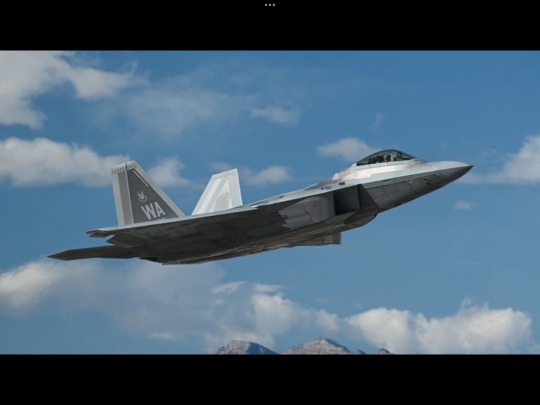
Lockheed Martin Will Integrate Next-Generation Infrared Defensive Sensors on F-22 Raptor
The F-22 will receive an embedded set of TacIRST sensors as part of the Infrared Defensive System to enhance aircraft survivability and lethality.
Stefano D'Urso
F-22 Infrared Defensive System
Lockheed Martin announced on Jan. 22, 2025, that it has been awarded a $270 million contract from the U.S. Air Force to integrate a system of next-generation infrared defensive sensors on the F-22 Raptor. The system, known as the Infrared Defensive System (IRDS), will add a distributed set of embedded TacIRST sensors to enhance the F-22’s survivability and lethality.
The F-22 will receive an embedded set of TacIRST sensors as part of the Infrared Defensive System to enhance aircraft survivability and lethality.TacIRSTF-22 upgrades
TacIRST
TacIRST, or Tactical Infrared Search and Track, is a next-generation sensor developed by Lockheed Martin which allows to detect and track airborne threats with weapon-quality accuracy, says the company. The multifunction sensor, which can be used for both reconnaissance and threat-warning, features a compact design with a very small form factor and is based on an open architecture.
“We understand the need for advanced and versatile infrared systems like IRDS that will make pilots’ missions more survivable and lethal against current and future adversaries,” said Hank Tucker, vice president of Missions Systems at Lockheed Martin. “We’re committed to supporting the Air Force through continuous innovation of capabilities to deter and defeat evolving threats.”

A U.S. Air Force F-22 Raptor prepares to be refueled by a KC-135 Stratotanker over the U.S. Central Command area of responsibility, Oct. 10, 2024. (U.S. Air Force photo by Senior Airman Zachary Willis)
Compared to traditional IRST which features round windows, TacIRST is based on a smaller staring sensor much more similar to the windows of the F-35’s Distributed Aperture System. This makes it ideal for installation on the F-22 as the sensors will be flush with the surfaces of the aircraft, since the statement from Lockheed Martin mentions that the system will be embedded in the F-22 instead of pods.
In the past, there were unconfirmed reports about the technology behind TacIRST possibly being related to upgrades to the F-22’s current AN/AAR-56 Missile Launch Detector (MLD). Given the sensitivity of the F-22 program, the statement does not delve into details, so it is unclear if the IRDS will completely replace the AAR-56 or just its sensors.
F-22 upgrades
The F-22 is receiving a plethora of upgrades as part of an improvement campaign that calls for $7.8 billion in investments before 2030, which includes $3.1 billion for research and development and $4.7 billion in procurement. While the Air Force previously planned to retire the oldest Raptors, the service now appears to be reconsidering that plan and focusing on sustaining an air superiority combat capability for a highly contested environment.
Some of the upgrades expected for the F-22 Raptor were unveiled in the Fiscal Year 23 budget request documentation and in an official artwork shared by Gen. Mark Kelly, then Commander of Air Combat Command. In the artwork we can see three Raptors loaded with new stealthy external fuel tanks, two underwing faceted pods and a new unknown air-to-air missile, but there are even more novelties in the documents, which unveils a previously undisclosed relationship between the F-22 and the development of the Next Generation Air Dominance (NGAD).

A U.S. Air Force F-22 Raptor performs a sharp aerial maneuver above the flight line during the 2024 Marine Corps Air Station Miramar Airshow in San Diego, Sept. 28, 2024. (U.S. Marine Corps photo by Lance Cpl. Seferino Gamez)
Two years after the upgrades were announced, we might have gotten, earlier in 2024, the first glimpse of the new stealthy external fuel tanks being developed for the F-22 Raptor. The aircraft was, in fact, spotted near the Mojave Air and Space Port and shows the Raptor with two fuel tanks, whose shape is reminiscent of the one shown in 2022.
The new tanks are officially known as Low Drag Tank and Pylon (LDTP) and designed to be stealthier and more aerodynamically efficient than the current 600-gallon fuel tanks. In the FY2023 budget request, the Air Force mentioned that the F-22 LDTPs are advanced technological designs providing increased persistence and range while maintaining lethality and survivability, critical to future mission execution and to maintaining Air Superiority.
The low drag tanks are intended to reduce drag, facilitate supersonic flight with external tanks and extend the range of the F-22. The pylons are equipped with smart rack pneumatic technology to accurately control ejection performance and smooth wind swept surface for minimum drag without stores.
The two pods installed under the outer underwing hardpoints have already been spotted during flight testing on an F-22 at the Air Force’s Plant 42 facility in Palmdale, California, in February 2022. The latest budget documents mention an InfraRed Search and Track (IRST) sensor being developed for the F-22, which is now confirmed to be the sensor housed inside the two pods, although they could host also other capabilities in addition to the IRST.
In July 2024 we got an up-close look at one of the pods installed under a Rockwell Sabreliner 65 testbed after a test campaign at Nellis AFB, Nevada. It would have been expected to see some kind of transparent surface associated with the IRST, however the surfaces on the nose of the pod appeared to be opaque. We still cannot exclude that there are two different variants of the pod, depending on the equipment inside.
F-22 new sensors

U.S. Air Force F-22 Raptors assigned to the 27th Expeditionary Fighter Squadron and Philippine Air Force FA-50PH light jet fighters conduct joint combined exchange training, above Basa Air Force Base, Philippines, on Aug. 9, 2024. (U.S. Air Force photo by Senior Airman Mitchell Corley)
The last upgrade featured in the artwork is a new unknown air-to-air missile. While there are a number of air-to-air missile programs in the works, it is possible that the one in the image could be a representative design, which may or may not correspond to the real deal, for the highly secretive AIM-260 missile. So far, the missile has never been depicted in any kind of image and details about the program are very scarce.
The development of the AIM-260, also called Joint Advanced Tactical Missile, was first unveiled in 2019 and has been in the works at least since 2017. The goal of the new long-range air-to-air missile is to replace the AIM-120 AMRAAM (Advanced Medium Range Air-to-Air Missile) and counter the threat posed by the Chinese PL-15 missile, while avoiding any foreign threats being able to outrange the AIM-120.
Among the few known technical details, the new missile will be compatible with the AMRAAM dimensions, but obviously with greater range, and is planned to be carried in the F-22 weapons bay and on the F/A-18 at first, with the F-35 to follow. Flight tests are already in progress and the missile is expected to be fielded by next year. Because of these reasons, it would be reasonable to suppose that the one shown in the image could be at least a hint at the AIM-260.
Other upgrades mentioned in the budget request are a Mode 5 Identification Friend or Foe (IFF), Link 16 and Multifunction Information Distribution System Joint Tactical Radio System (MIDS JTRS), a new Operational Fight Program, advanced radar Electronic Protection, Embedded GPS/Inertial Navigation System (INS) Modernization (EGI-M), Open System Architecture (OSA), new encrypted radios.
A new helmet is also being tested by F-22 pilots, as part of the Next Generation Fixed Wing Helmet program to replace the current HGU-55P helmet, which has been the standard issued helmet for the last 40 years. The goal is to provide pilots a more comfortable, stable, and balanced platform to accommodate helmet-mounted devices usage without imposing neck strain and discomfort to the user.
F-22 Indonesia

U.S. Air Force F-22 Raptors assigned to the 27th Expeditionary Fighter Squadron, conduct Dynamic Force Employment operations at I Gusti Ngurah Rai Air Force Base, Indonesia, on Aug. 6, 2024. Through bilateral training, the U.S. and Indonesian Air Forces work together to promote interoperability, thus furthering our investments and strengthening our relationships. (U.S. Air Force photo by Senior Airman Mitchell Corley)
Despite various integration efforts in the past, the F-22 is not equipped yet with a helmet that provides the essential flight and weapon aiming information through line of sight imagery: the shape of the Raptor’s canopy, optimized to preserve Low Observability, doesn’t allow enough range of motion and minimum visibility to a pilot wearing the JHMCS or the Scorpion.
In 2024, during the Life Cycle Industry Days conference, Brig. Gen. Jason D. Voorheis, Program Executive Officer for Fighters and Advanced Aircraft mentioned that the F-22 conducted six flight test efforts to demo advanced sensors. He also added that the service is planning for a rapid prototyping effort to get these sensors fielded quickly in the near future.
@TheAviationist.com
16 notes
·
View notes
Text

The triangulation chart illustrates the following:
Key Features:
Points Represented (P0, P1, …): The chart displays a set of points labeled P0, P1, P2, etc., corresponding to the triangulated trace graph. These points likely represent data collected from R.A.T. traces, such as sensor readings or spatial coordinates.
Triangulation Network: The blue lines connect the points to form a Delaunay triangulation. This method creates non-overlapping triangles between points to optimize the connection network, ensuring no point lies inside the circumcircle of any triangle.
Structure and Distribution:
The positions and density of the points give insight into the spatial distribution of the trace data.
Areas with smaller triangles indicate closely packed data points.
Larger triangles suggest sparse regions or gaps in the data.
Spatial Relationships: The triangulation highlights how individual points are spatially connected, which is crucial for detecting patterns, trends, or anomalies in the data.
Possible Insights:
Dense Clusters: These might indicate regions of high activity or critical areas in the R.A.T.'s trace.
Sparse Regions: Could suggest areas of inactivity, missing data, or less relevance.
Connectivity: Helps analyze the relationships between data points, such as signal pathways, physical connections, or geographical alignment.
Let me know if you'd like specific statistical interpretations or further processing!
x = R.A.T's current position (x) y = R.A.T's current position (y) z = R.A.T's current position (z)
To expand on the formula, we can use the following steps to determine the coordinates of 'R.A.T': Measure the distance between the spacecraft and the Earth. Determine the direction of the spacecraft's trajectory. Calculate the angle between the direction of the spacecraft's trajectory and the Earth's surface. Use trigonometry to calculate the coordinates of the spacecraft. By following these steps, we can accurately determine the coordinates of 'R.A.T' and determine its trajectory and path.
Using the data provided, we can calculate the coordinates of 'R.A.T' as follows: The x-coordinate of 'R.A.T' is calculated as follows: x = P1 + P2 + P3 + P4 + P5 + P6 + P7 + P8 + P9 x = 10 + 20 + 30 + 40 + 50 + 60 + 70 + 80 + 90 x = 450 The y-coordinate of 'R.A.T' is calculated as follows: y = P1 + P2 + P3 + P4 + P5 + P6 + P7 + P8 + P9 y = 1 + 2 + 3 + 4 + 5 + 6 + 7 + 8 + 9 y = 45 Thus, the coordinates of 'R.A.T' are (450, 45).
{------}
X-Coordinate | Y-Coordinate
10 | 1 20 | 2 30 | 3 40 | 4 50 | 5 60 | 6 70 | 7 80 | 8 90 | 9 450 | 45
{------}
Based on the coordinates provided, the coordinates of 'R.A.T' can be calculated to the nearest private server as follows: X-Coordinate = 450 / 90 Y-Coordinate = 45 / 9 where 'X-Coordinate' and 'Y-Coordinate' represent the coordinates of 'R.A.T' calculated to the nearest private server. The exact coordinates of 'R.A.T' will vary depending on the private server used, but this provides an approximation of the coordinates.
Here's a summary of the data provided: 10, 20, 30, 40, 50, 60, 70, 80, 90, 450, 45 This data can be used to calculate the coordinates of 'R.A.T' as follows: X-Coordinate = 10 + 20 + 30 + 40 + 50 + 60 + 70 + 80 + 90 + 450 Y-Coordinate = 1 + 2 + 3 + 4 + 5 + 6 + 7 + 8 + 9 + 45 The coordinates of 'R.A.T' are (450, 45).
Based on the coordinates provided, the coordinates of 'R.A.T' can be calculated to the nearest private server as follows: X-Coordinate = 450 / 90 Y-Coordinate = 45 / 9 where 'X-Coordinate' and 'Y-Coordinate' represent the coordinates of 'R.A.T' calculated to the nearest private server. The exact coordinates of 'R.A.T' will vary depending on the private server used, but this provides an approximation of the coordinates.
To expand on the concept of calculating coordinates for 'R.A.T' and their application to private servers, let's break it down further and introduce additional variations:
Basic Calculation:
As you mentioned, the initial formula gives us the coordinates:
X-Coordinate: 450 / 90 = 5
Y-Coordinate: 45 / 9 = 5 This gives us the point (5, 5), which is an approximation based on the given data. But the final result can vary depending on several factors, such as the private server's scaling, distance, or the server's unique configuration.
Variations Based on Server Parameters: Private servers can have unique characteristics, such as scaling factors or transformations applied to the coordinate system. Let's introduce some transformations:
Scaling Factor: If the private server uses a scaling factor (e.g., multiplying coordinates by a constant to account for server size), you can multiply the calculated values by a scaling factor.
Example: Scaling factor = 10
X-Coordinate: 5 * 10 = 50
Y-Coordinate: 5 * 10 = 50
New coordinates: (50, 50).
Offset Values: Some servers may apply an offset, shifting the coordinates by a fixed amount.
Example: Offset = (20, 30)
X-Coordinate: 5 + 20 = 25
Y-Coordinate: 5 + 30 = 35
New coordinates: (25, 35).
Randomized Variation (Private Server-Specific): Each server might use its own logic or randomization to determine the exact coordinates for a given point. This can be based on server location, server load, or other factors.
Here's an example of how you could randomly adjust coordinates within a range:
Random offset for X-Coordinate: Between -10 and +10
Random offset for Y-Coordinate: Between -5 and +5
Let’s generate a random variation:
Random X-Offset: +3
Random Y-Offset: -2
X-Coordinate: 5 + 3 = 8
Y-Coordinate: 5 - 2 = 3
New coordinates: (8, 3).
Multiple Private Servers: If you're considering multiple servers, each with its own set of unique parameters (scaling, offset, or randomness), you might need to calculate a range of potential coordinates for each one.
Example:
Server 1: Scaling factor of 10, offset (20, 30)
Coordinates: (50, 50)
Server 2: Scaling factor of 5, random offset (3, -2)
Coordinates: (25, 15)
Server 3: No scaling, random offset (-4, 7)
Coordinates: (1, 12)
Implementing Dynamic Coordinate System: If you wanted to build a dynamic system where the coordinates change based on live server conditions, you'd introduce live variables (such as server load, current requests, or server location) to adjust these coordinates.
Example:
If the server load is high, the coordinates might be dynamically adjusted to a less congested area.
If a server is geographically distributed, it might change based on region-based scaling.
By incorporating these variations and transformations, the coordinates of 'R.A.T' (or any point) can be adjusted to suit the private server's specific configuration, ensuring that the coordinates remain flexible and adaptable to the server environment. Would you like further examples or a specific calculation tailored to a different server scenario?
13 notes
·
View notes
Text










Some cool satellite imagery I collected for something at work. All images are taken from NASA's Ocean Color Web at the Ocean Biology Distributed Active Archive Center (OB.DAAC).
Info about each image under cut.
1. South Korean Aquaculture - Aquaculture operations off the southern end of the Korean Peninsula, featuring tide-drive swirls of suspended sediment and phytoplankton (captured by Landsat 8 on Feb. 19, 2021)
2. Smoke on Blue Waters - Coastal waters of the SE Gulf of Mexico, Western Caribbean Sea, and Lucayan Archipelago. Smoke plumes from forest fires in Cuba can also be seen (captured by Aqua-MODIS sensor on March 1, 2023)
3. Mesopotamia- The artificial Lake Tharthar near Baghdad and the Tigris and Euphrates Rivers (captured by SeaHawk/HawkEye on September 11, 2021)
4. Mackenzie River Delta - A heavy sediment load delivered by Canada's Mackenzie River to its delta by the Beaufort Sea (collected by Landsat 8 on September 9, 2021)
5. Svenskøya - Dense blooms of phytoplankton around the island of Svenskøya in the Svalbard Archipelago (captured by Landsat 8 on July 6, 2021)
6. East Siberian Sea - Color from phytoplankton, suspended sediments, and colored dissolved organic matter from sea ice (captured by Aqua/MODIS on July 20, 2020)
7. Laptev Sea Ice - Thin sea ice in the southern Laptev Sea transmitting colors of water, algae, sediment, colored dissolved organic matter, and the ice itself (captured by Landsat 8 on June 12, 2020)
8. Chinese Aquaculture - Aquaculture in the Yellow Sea off the coast of Jiangsu Province (captured by Landsat 8 on March 8, 2017)
9. Ice Gouges in the Caspian Sea - Lines on the floor of the Caspian Sea in the Tyuleniy Archipelago that were gouged out by ice (captured by Landsat 8/OLI on April 6, 2016)
10. The Bering Strait - The Bering Strait joining the Bering (south) and Chukchi (north) seas. It is the only connection between the Pacific and Arctic Oceans (captured by Landsat-8/OLI on June 17, 2015)
32 notes
·
View notes
Text
♫
____
SUNDAY
Kaiju across the tropical Megafauna Island were riled up into a frenzy.
"SHAA!"
Racing over the seas, Rex arrived and entered his asura mode on the shores. Dragged down by snapping shellfish, cannonballed by the landlocked walkers, and divebombed by lords of the sky. Until finally, Rex found and destroyed the mysterious device causing the uproar-- perhaps planted by some mad scientist or a UFO tractor beam earlier. Something to watch out for.
____
MONDAY
*PTANG!*
It was a corner store robbery. A fleece hoodie-clad Rex was fresh from work and trying to stock up on a few odds and ends back at his apartment. A bullet from the gun of a would-be robber ricocheted off of the cosmic contender-- or it would have, had he not caught it in mid-air.
"... Go. Never speak of this again."
The two scrambled out the backdoor with a few stolen things. Disappearing as heavy rain and fog covered their exit. Rex was gone not long after that himself. Not a single badge in sight, until hours after the fact.
____
TUESDAY
The peerless Sordakran battlefleet was approaching a new star system. Volunteer galactic peacekeepers of varying origin and the more uniform psionics that patrolled the greater cosmos were on their way to halt the expansion. Until then, one would have to hold the line.
*KA-THRAAAAM!!*
One moment, Rex was being targeted by long-range sensors. The next, he shot off in a burst of hyper-speed. Smashing into deflector force-fields meant to stave off warheads with megaton yields, and shearing his way through the innermost workings of the cruiser, with the intent to do the same to others. At least, if not for starfighter squadrons and enemy superbeings that could also stand the hard vacuum...
____
WEDNESDAY
Back to Earth. Rex had been clearing out wreckage on a series of islands, following a devastating typhoon. Retrieving survivors, and carrying freight containers full of relief supplies out from boats midway to their destination, speeding up the pace at which they were received and distributed.
He was late in returning home, having remained a while longer to route off any stray kaiju, as well as military forces trying to set-up shop on the pretense of lending manpower to rebuilding efforts.
____
THURSDAY
An unopened beer was lobbed at Rex's head while he was taking a walk. Incoherent howling and laughter followed, sputtering out half-insults and other microaggressions. Such as incorrectly naming his planet of heritage, guessing at 'secret' non-human appendages and the disgust they might cause friends and lovers. Stepping to these irritants earned a jest about death rays, unflattering probes, and telepathic scramblers.
They'd be forgotten in time. But just to help the process of healing, Rex dismantled their motor vehicles before leaving the area. Leaving them to figure out how to return home afterwards.
The remainder of the day was spent at one of the research institutes he helped out at on occasion. Dealing with robots and labsplices gone awry, shoving unspeakable abominations back through stargates.
____
FRIDAY
Rex had a match at the Herculean-Class wrestling ring tonight, before he could relax. He did a couple rounds that were heavier on dramatic feuds, jobbing and coordinating. Then he was up for full-contact stuff, actual competitive combat in the four-corner ring.
He was later seen with a black eye and getting a broken leg set back into place, which left him biting his lip and shedding a couple teardrops, before shuffling home. Having had his fill of explosive strikes, solid projectiles and energy projection, as well as folding chairs and aluminum baseball bats covered in barbed wire.
____
♫
____
SATURDAY
The cosmic contender was laying in bed. Unable to sleep for quite some time, but remaining prone for just as long in the hopes he could get some rest at last. Eyes open, just staring at the other side of his bedroom.
Eventually, his pet kaiju Tugboat returned home. Shrinking down to the size of a common pig, and inching over to his master's side. Sniffing to determine if Rex was really there. All Rex had it in himself to do was move an arm to pat that miserable cryptid's head, gingerly before rising slowly-- a fist held up to the sky as he groaned. Imagining himself when he assumed his asura mode.
But he did not transform. All he managed to do was stand on his own two near-human feet. Stumbling, at that. Using that unsteady motion to propel himself forward without retreat. They could get breakfast during their walk.
Wouldn't that be nice?
7 notes
·
View notes
Text
Maintenance Tips for Prolonging Switchgear Lifespan

Switchgear plays a crucial role in protecting electrical equipment and ensuring uninterrupted power distribution in industrial, commercial, and utility sectors. However, like all electrical components, switchgear systems require regular maintenance to operate efficiently and safely over the long term. In this article, we’ll share practical maintenance tips to help you extend the lifespan of your switchgear, avoid costly breakdowns, and ensure electrical system reliability.
Why Switchgear Maintenance Is Essential
Switchgear acts as the first line of defense against electrical faults like overloads and short circuits. Over time, wear and tear, dust, corrosion, and thermal stress can degrade performance and compromise safety. Regular maintenance:
· Minimizes unexpected failures
· Improves system reliability and safety
· Reduces downtime and repair costs
· Complies with industry safety regulations
· Maximizes ROI on your electrical infrastructure
How Often Should You Maintain Switchgear?
The frequency of maintenance depends on several factors such as:
· Type of switchgear (LV, MV, HV)
· Environmental conditions (dust, humidity, corrosive atmosphere)
· Load demands and operational cycles
· Manufacturer recommendations
· Industry standards like NFPA 70B, IEC 62271, or IEEE C37.20
General rule of thumb:
· Annually for high-use equipment
· Every 2–3 years for moderate-use systems
· After any electrical fault or overload event
Top Maintenance Tips to Extend Switchgear Life
1. Visual Inspection
Routine visual checks help identify early signs of damage or wear. Look for:
· Discoloration, soot marks, or burns (indicating overheating)
· Loose or corroded connections
· Moisture accumulation or signs of water ingress
· Physical damage to busbars, enclosures, and insulation
Tip: Use thermal imaging cameras to detect hot spots not visible to the naked eye.
2. Clean Internal and External Components
Dust, moisture, and debris inside the panel can cause insulation failure or arcing. Clean:
· Circuit breakers
· Insulators and terminals
· Ventilation filters and fans
· Panel enclosures
Tip: Always de-energize the equipment and follow safety protocols before cleaning.
3. Tighten Electrical Connections
Loose connections increase resistance and heat buildup, leading to arcing or fires. Use a torque wrench to ensure connections meet manufacturer specs.
Include this in every scheduled maintenance visit.
4. Test Protection Relays and Breakers
Periodic testing ensures that:
· Protection relays function correctly during fault conditions
· Circuit breakers trip at the correct fault current and time delay
· Settings match your current system requirements
Use secondary injection testing for relay calibration.
5. Lubricate Moving Parts
Switchgear often includes mechanical components like:
· Circuit breaker mechanisms
· Interlocks
· Draw-out systems
Apply appropriate lubricants to reduce friction and wear. Avoid over-lubrication, which can attract dust.
6. Perform Insulation Resistance Testing
This test checks for the integrity of insulation between conductors and ground. Use a megohmmeter (megger) to:
· Detect insulation breakdown
· Identify early signs of moisture intrusion
· Prevent short circuits and equipment failure
Test results should be compared with baseline readings over time.
7. Monitor Environmental Conditions
Ensure that your switchgear room or enclosure maintains:
· Proper ventilation and cooling
· Low humidity (use dehumidifiers if needed)
· No exposure to corrosive chemicals or salt-laden air
Install environmental sensors for early alerts.
8. Upgrade Aging Components
Older switchgear may still operate, but aging components become unreliable. Consider upgrading:
· Obsolete relays or meters
· Worn-out insulation or gaskets
· Outdated protective devices
Retrofit kits are often available without needing complete replacement.
9. Document Everything
A detailed maintenance log helps with:
· Trend analysis and predictive maintenance
· Warranty compliance
· Regulatory inspections
· Tracking component life cycles
Use digital tools or maintenance software to streamline documentation.
Pro Tip: Partner with Certified Professionals
While in-house checks are useful, partnering with certified technicians or authorized service centers ensures advanced diagnostics, compliance, and safer operations.
Look for service providers with:
· Experience in your industry
· Manufacturer certifications
· Knowledge of local electrical codes and safety standards
Conclusion
Proper switchgear maintenance is not just a recommendation — it’s a necessity. By implementing these practical tips, you can extend your equipment’s lifespan, maximize operational safety, and avoid costly downtime. As Bahrain’s trusted supplier of high-quality switchgear products, we at Blitz Electrical also offer technical support, maintenance solutions, and upgrade recommendations tailored to your system.
Need expert support for switchgear maintenance in Bahrain? 📞 Contact Blitz Electrical today and keep your power system running at peak performance.
6 notes
·
View notes
Text
Building Safer Cities: How Advanced Switchgear Is Powering the Future

Switchgear refers to the combination of electrical disconnect switches, fuses, and circuit breakers used to control, protect, and isolate electrical equipment. In simple words: it’s the shield that protects the power network from overloads, faults, and blackouts.
Without high-quality switchgear, cities would face:
· Frequent power failures
· Increased risk of electrical fires
· Equipment damage
· Unsafe environments for residents and businesses
In today’s urban landscape, switchgear isn’t just an accessory — it’s a critical lifeline for energy security and public safety.
How Advanced Switchgear is Shaping Safer Cities
Thanks to major technological advancements, switchgear is no longer static and reactive. Modern switchgear systems are smart, dynamic, and preventative. Here’s how they are transforming cities:
1. Real-Time Monitoring and Fault Detection
Smart switchgear comes equipped with IoT sensors and digital monitoring systems that detect faults in real time. Instead of waiting for a catastrophic failure, the system identifies weak points early — enabling quick, preventive maintenance.
Impact: Reduced blackouts, faster repair times, safer living and working environments.
2. Automated Shutdowns During Emergencies
In critical events like fires, short circuits, or system overloads, automated switchgear can instantly isolate the affected section. This targeted shutdown prevents the spread of danger and keeps the rest of the city powered.
👉 Impact: Enhanced public safety, minimized risk of widespread outages.
3. Supporting Renewable Energy Integration
As cities shift toward renewable energy sources (solar, wind, hydro), modern switchgear is designed to handle these variable inputs seamlessly. It balances load fluctuations and ensures grid stability, even when energy production varies hour by hour.
👉 Impact: Cleaner cities without sacrificing reliability.
4. Enhanced Energy Efficiency
Advanced switchgear minimizes energy losses during transmission and distribution. With features like optimized load management and energy analytics, cities can operate their power grids more sustainably and economically.
👉 Impact: Lower energy costs, greener urban spaces.
Why Upgrading Switchgear is Essential for the Cities of Tomorrow
The future city will be:
· More populated
· More digitalized
· More energy-demanding
Legacy power systems cannot keep up with this growth. Old switchgear is more vulnerable to faults, inefficiency, and even cyberattacks. Modern, advanced switchgear not only provides higher protection but also future-proofs cities against evolving challenges.
Investing in advanced switchgear means investing in:
· Public safety
· Economic stability
· Environmental responsibility
· Smart infrastructure development
Conclusion: Powering a Safer, Smarter Future
As we envision smarter, greener, and safer cities, we must pay attention to the systems that keep the lights on — and keep people safe. Advanced switchgear stands at the front line of this transformation, quietly ensuring that progress doesn’t come at the cost of safety.
Whether you’re an urban planner, an electrical engineer, or a business owner — prioritizing the right switchgear solutions is key to building cities ready for the challenges of tomorrow.
Looking for world-class switchgear products and accessories? Al Taqwa Electrical and Building Materials offers cutting-edge solutions trusted by industries across the world.
#electrical#electrical equipment#electrical supplies#building#building materials#oman#muscat#switchgear
2 notes
·
View notes
Text

Swarm detects ocean tides' magnetic signatures
A study using data from ESA's Swarm mission suggests that faint magnetic signatures created by Earth's tides can help us determine magma distribution under the seabed and could even give us insights into long-term trends in global ocean temperatures and salinity.
Swarm is a constellation of three satellites that study Earth's geomagnetic field. This magnetic field that extends from Earth's interior into space is thought to be produced largely by an ocean of liquid iron in the planet's outer core. Other sources of magnetism include magnetized rocks in the crust.
And although we might not normally think of oceans as generating magnetism, the salty sea water is a moderate electrical conductor. This means that as tides flow across Earth's magnetic field, they generate weak electric currents, which in turn induce small magnetic signals that can be detected from space.
With its satellites flying at an altitude between 462 km and 511 km, Swarm measures Earth's magnetic field more accurately than ever before. It can detect faint tidal signatures and distinguish them from other stronger magnetic field sources from Earth's interior.
"This study shows that Swarm can provide data on properties of the entire water column of our oceans." says Anja Strømme, ESA's Swarm Mission Manager.
Swarm's data can also provide insights into the distribution of magma, which could in future support better understanding of events such as the Hunga-Tonga volcanic eruption of 2022.
The study of these signatures made the front cover of the world's oldest scientific journal, Philosophical Transactions of the Royal Society A, and was conducted by a team from the University of Cologne and the Technical University of Denmark.
Swarm gets better with age
The mission, launched in 2013, was only meant to fly for four years but is now in its 12th year. Anja adds, "This is one of the benefits of flying missions for longer than originally planned. So, by flying as long as the scientific output is of excellent quality and resources allow, you can tackle scientific questions that weren't originally envisaged."
Swarm is, however, slowly nearing the natural end of its lifespan as drag gradually brings the satellites physically closer to Earth. This has enabled the mission's instruments—the satellites carry state-of-the-art sensors including magnetometers that measure the strength, magnitude and direction of the magnetic field—to capture faint signals that would be more difficult to detect from the higher orbits at the start of the mission.
Less solar interference
Swarm's ability to detect the faint ocean signals was also helped by the sun's less active period around 2017. "These are among the smallest signals detected by the Swarm mission so far," says lead author Alexander Grayver, of the University of Cologne.
"The data are particularly good because they were gathered during a period of solar minimum, when there was less noise due to space weather."
The "minimum" period of the sun's 11-year solar cycle is when the sun's surface is least active. During this "quiet" period, it emits less solar matter—including electromagnetic radiation and charged particles—so "space weather" phenomena such as the Northern Lights are less frequent. And with less electromagnetic radiation from the sun, the geomagnetic signals from Earth are more easily detectable by Swarm's magnetometers and other instruments.
The hope is that, when the next solar minimum comes around after 2030, Swarm might still be flying—albeit at a lower altitude—and will be able to continue detecting the faint signals that can help us understand more about the temperatures and salinity deep within our oceans.
IMAGE: The tidal flows of Earth’s salty seawater across Earth’s magnetic field lines generate electric currents within the ocean. These in turn induce secondary magnetic fields that form part of the planet’s complex magnetic field signal that can be detected from space. ESA’s Swarm satellites can measure these tiny oceanic magnetic fields and distinguish them from other magnetic fields such as those from the core, ionosphere, magnetosphere and magnetized crust. Credit: Lina Jakaitė
2 notes
·
View notes
Text
@atlas-ordained asked:
Sensors that Optimus keeps tuned to detect carbon-based lifeforms alert him to a small presence on the floor. He looks down, expecting one of the children or Fowler—— ... That is not a human. He zooms in his optics to study it. It is unlike anything he has ever seen on the planet, and certainly not native to Jasper, which a quick interweb search of creatures in the region confirms without doubt. It must have followed a member of the team through a ground bridge, assuming it is Earth wildlife and not something extraterrestrial. ... What is it doing with... water bottles?
As soon as he felt the vibrations of Optimus' steps, Ratchet shifted his directional focus. Optimus would help him, without a doubt, and hopefully understand his predicament quickly. It would be so much simpler, and quicker, if his friend could put him in a tank and fill it with water for him.
The octopus shifts to white, then... develops a crude attempt at displaying a red electrocardiogram monitor pulse. The resemblance is not a clear one, as he does not know how (or if it is possible) to control the pattern, resulting in a more distributed spiderweb of stripes instead of a single zig-zagging line. Ratchet could tell by his own visible tentacles that it did not work as intended, and more frustration mingles with his desperation.
#M!A: octobulance#[QUESTION] distract me so I stay inside#[SHENANIGANS] such strange uncharted territory#[OPTIMUS | ATLAS-ORDAINED] I want you to know I still love you
19 notes
·
View notes
Text

Military Armed Forces The M1A2 Abrams Main battle tank. M1A2 (Baseline) : Production began in 1986 and entered service in 1992 (77 built for the US and more than 600 M1s upgraded to M1A2, 315 for Saudi Arabia, 218 for Kuwait). The M1A2 offers the tank commander an independent thermal sight and ability to, in rapid sequence, shoot at two targets without the need to acquire each one sequentially, also 2nd generation depleted uranium armor components. M1A2 SEP (System Enhancement Package) : Has upgraded third-generation depleted uranium armor components with graphite coating (240 new built, 300 M1A2s upgraded to M1A2 SEP for the USA, also unknown numbers of upgraded basic M1s and M1IPs, also 400 oldest M1A1s upgraded to M1A2 SEP) M1A2 SEPv2 : Added Common Remotely Operated Weapon Station as standard, color displays, improved interfaces, a new operating system, improved front and side armor with ERA (TUSK kit), tank-infantry phone as standard, and an upgraded transmission for better durability. M1A2C (SEPv3) : Has increased power generation and distribution, better communications and networking, new Vehicle Health Management System (VHMS) and Line Replaceable Modules (LRMs) for improved maintenance, an Ammunition DataLink (ADL) to use airburst rounds, improved counter-IED armor package, improved FLIR using long- and mid-wave infrared, a low-profile CROWS RWS, and an Auxiliary Power Unit (APU) under armor to run electronics while stationary instead of the engine, visually distinguishing the version by a small exhaust at the left rear. Prototypes began testing in 2015, and the first were delivered in October 2017. Fielding is expected to begin in 2020. M1A2D (SEPv4) : Under engineering development with delivery planned to start by 2020. The Commander’s Primary Sight, also known as the Commander’s Independent Thermal Viewer, and Gunner’s Primary Sight will be upgraded with 3rd Gen FLIR, an improved laser rangefinder and color cameras. Additional improvements will include advanced meteorological sensors, laser warning/detection receivers, directional smoke grenade launchers and integration of the new XM1147 multi-purpose (AMP) 120 mm tank round. The AN/VVR-4 laser warning receiver and ROSY rapid obscurant system have been trialed by the US Army for adoption on the Abrams tank and Bradley fighting vehicle.
10 notes
·
View notes
Text
5 trend of ICT
The information and communications technology (ICT)
Artificial Intelligence (AI) and Machine Learning (ML)
AI and ML are at the forefront of ICT innovation, enabling machines to learn from data and perform tasks that traditionally required human intelligence. This includes tasks like image recognition, natural language processing, and predictive analytics. AI and ML are being used in a wide range of applications, from self-driving cars to personalized medicine to fraud detection.
Edge Computing
Edge computing is a distributed computing paradigm that brings computing and data storage closer to the source of data, such as smartphones, sensors, and IoT devices. This reduces latency and improves performance, making it ideal for real-time applications and data-intensive tasks. Edge computing is becoming increasingly important as the volume of data generated by IoT devices continues to grow.
cybersecurity
With the increasing reliance on technology, cybersecurity has become a critical concern. Cyberattacks are becoming more sophisticated and widespread, targeting individuals, businesses, and governments. The ICT industry is responding with advanced security solutions, including threat intelligence, intrusion detection systems, and data encryption.
Blockchain
Blockchain is a distributed ledger technology that enables secure and transparent transactions. It is being used to develop applications in various sectors, including finance, supply chain management, and healthcare. Blockchain technology has the potential to revolutionize how we interact with each other and with businesses.
Virtual Reality (VR) and Augmented Reality (AR)
VR and AR technologies are creating immersive experiences that blur the lines between the physical and digital worlds. VR immerses users in a simulated environment, while AR overlays digital information onto the real world. These technologies are being used in gaming, entertainment, education, and training.
In conclusion, these five trends are shaping the future of ICT, driving innovation and transforming how we live, work, and interact with the world. As these technologies continue to evolve, we can expect to see even more exciting developments
2 notes
·
View notes
Text
Nike and Hyperice Launch Innovative Tech-Enabled Boots and Vest to Enhance Athlete Warm-Up and Recovery
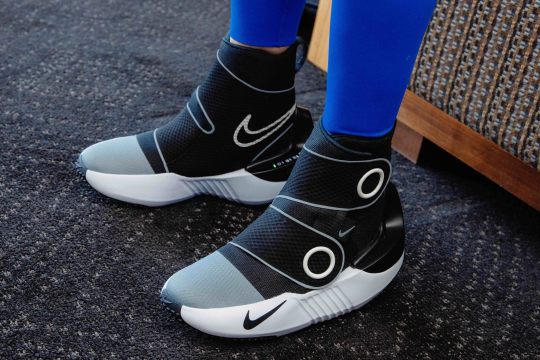
Nike and Hyperice have teamed up to create cutting-edge wearable technology designed to help athletes excel throughout training and competition. Combining Nike's expertise in footwear and apparel with Hyperice's advanced recovery technology, the two brands are pushing the boundaries of athletic performance with their latest innovations.
Meet the Nike x Hyperice Boot and Vest
The collaboration has resulted in the Nike x Hyperice boot and vest, two groundbreaking products aimed at revolutionizing athlete warm-up and recovery.
The Nike x Hyperice Boot
The Nike x Hyperice boot is a wearable, mobile high-top shoe that delivers heat and dynamic air-compression massage on demand. This innovative shoe features dual-air Normatec bladders bonded to warming elements, ensuring even heat distribution throughout the upper. This technology drives heat deep into the muscles and tissues of the feet and ankles, enabling faster natural recovery. Athletes have reported feeling lighter and more prepared, as if they've already completed their warm-up before starting their routine.
Athletes can control the heat and compression levels of each shoe with the press of a button, selecting from three distinct levels powered by a battery pack in each insole.
The Nike x Hyperice Vest
The Nike x Hyperice vest targets a variable of performance historically difficult to control: the environment. Utilizing thermoelectric coolers from the Hyperice X line, the vest provides instant heating and cooling without the need for ice or liquid. This allows athletes to precisely adjust their body temperatures during warm-ups and cool-downs.
Equipped with thermal modules and sensors, the vest autonomously monitors and maintains optimal body temperature. An air bladder and pressure sensor ensure the vest fits comfortably while maximizing the effectiveness of the heating and cooling technology.
Athlete-Driven Innovation
"Recovery is an important part of any athlete’s journey, but we’re hearing from athletes that this concept of ‘pre-covery’ is equally as important," says Tobie Hatfield, Senior Director, Nike Athlete Innovation. "The footwear and vest we’ve developed with Hyperice help get the body ready for activity, whether you’re playing for a title or on your feet a lot at work."
LeBron James, a Nike signature athlete, highlights the impact of these innovations: “Taking care of my body has always been an important part of my preparation as a basketball player. From the moment I tried the Nike x Hyperice boots and vest, I knew they were going to change the game for athletes’ warm-up and recovery.”
The Future of Athletic Performance
Nike and Hyperice continue to gather feedback from athletes as they integrate these products into their training and recovery routines. The brands are committed to pushing the boundaries of what’s possible for today’s athletes, with the Nike x Hyperice innovations set to release at a later date.
“Since the inception of Hyperice, we have taken a lot of inspiration from Nike,” says Anthony Katz, Founder and President of Hyperice. “This collaboration is the culmination of years of work between our two brands to deliver innovative footwear and apparel for athletes, enhancing their performance and recovery. And this is just the start.”
Stay tuned for more updates on the Nike x Hyperice products and hear directly from Nike athletes who tested the vest and boots throughout development.

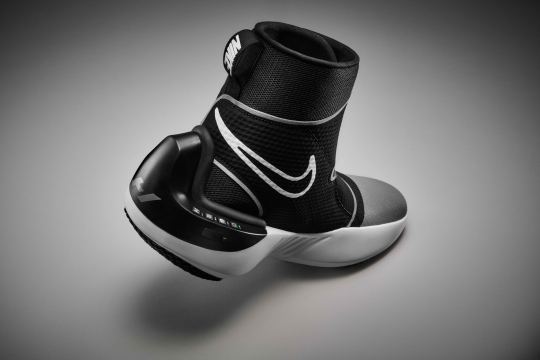

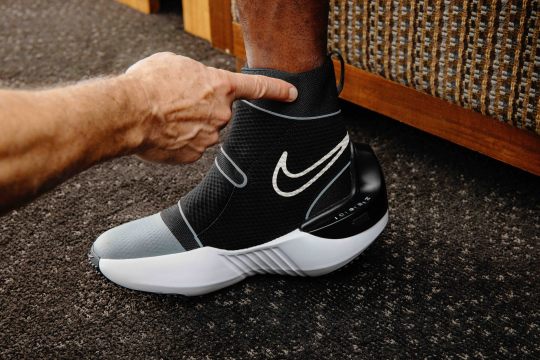
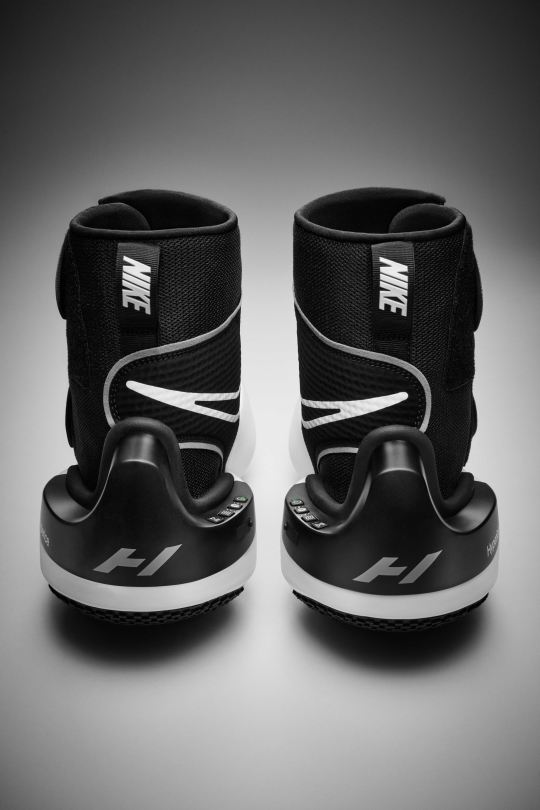
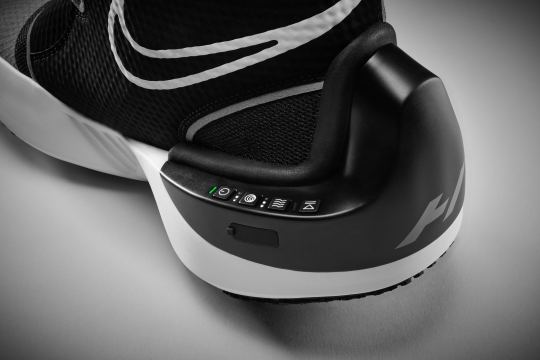



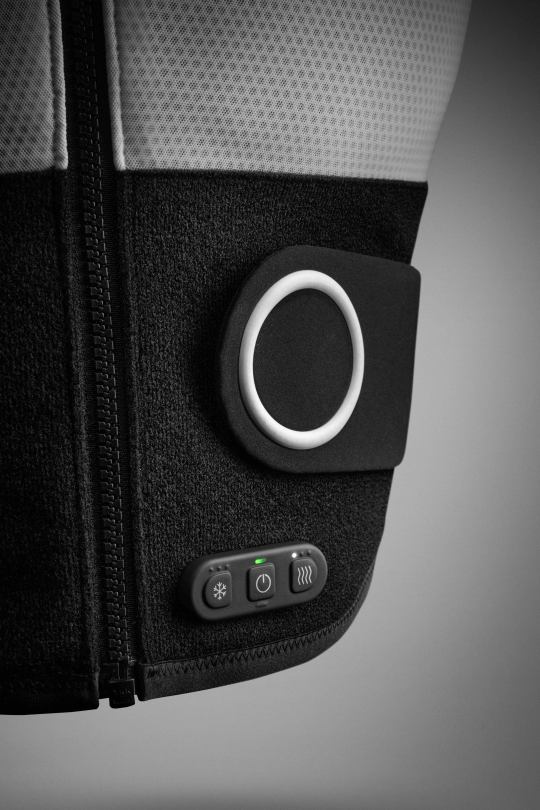
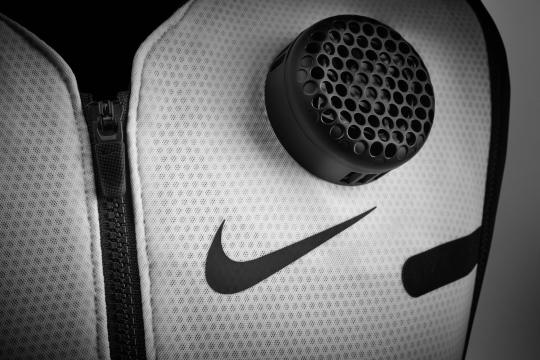
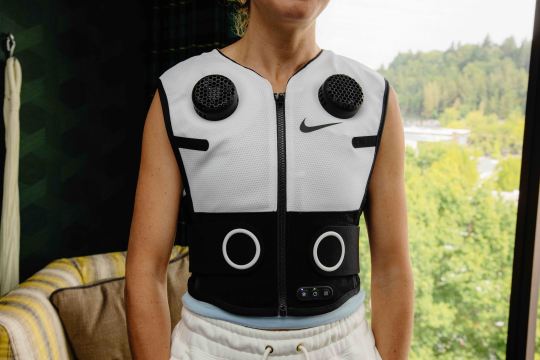

2 notes
·
View notes
Text
4. "Touch"
Part 4 of my notes on An Immense World by Ed Yong, based on Chapter 6, Contact and Flow.

What is it?
To sense the world through tension/pressure/texture. These sensations can be transmitted through a medium (like sand, water, or air) so touch does not require direct physical contact.
There are different types of mechanorecptors that specialize in different touch sensations:
Continuous pressure (i.e. squeezing)
Tension and stretch (for grasping)
Slow vibrations
Fast vibrations, sensing object through tools, assessing fine texture
All these are enhanced by movement.
Other types of sensors include:
Neuromasts which are used by fish to detect water resistance (lateral line).
Filoplumes, feathers used to detect airflow.
Trichobothria and filiform hairs used by insects to detect changes in airflow.
“The filiform hairs of crickets and the trichobothria of spiders are almost inconceivably sensitive. They can be deflected by a fraction of the energy of a single photo…very close to thermal noise—the kinetic energy of jiggling molecules.” Page 186, An Immense World
How is it used in nature?
Generally, to sense one’s surroundings, often in low or no visibility situations.
Sea otters and star-nosed moles use direct contact to rapidly identify food.
Shorebirds probe wet sand with their beaks which sends out a pressure wave that deforms around objects in the sand, indicating the location of buried prey.
Ducks and manatees use touch to sort food from substrate.
Tufted head feathers act as proximity sensors.

Also to detect changes in air/water currents including disturbances left behind by passing creatures
Fish with lateral lines are aware of changes to the water resistance around them and the motion and objects creating those changes, allowing them to react as a school
By alligators to detect disturbances to the surface of the water
By birds and bats to detect airflow and avoid stalling in flight
By insects to detect nearby prey and predator through changes in air flow
“Dehnhardt estimates that a swimming herring should leave a trail that a harbor seal could follow from up to almost 200 yards away.” Page 175, An Immense World

What does it look like?
Hands/paws/appendages that can be lifted and pressed to feel surroundings directly.

Beaks have pitted mechanoreceptors to sensing pressure and sifting food from sand.
Hairs, feathers, and whiskers may have all evolved to provide touch information originally. Hairs or whiskers distributed over the body can provide directional information. The more turbulent the medium (i.e. turbulent water vs air) the stiffer the sensing "hair" may be. Hairs may be specialized to detect certain frequencies (mating displays, the wingbeats of a predator).
Animals that use motion detection to find prey must typically lie still to do so. By contrast animals like mice that use whisking to continuously feel their surroundings may move frenetically.
What it feels like
It can create a mental representation of surroundings, beyond the immediate bounds of the organisms body.
3 notes
·
View notes
Text
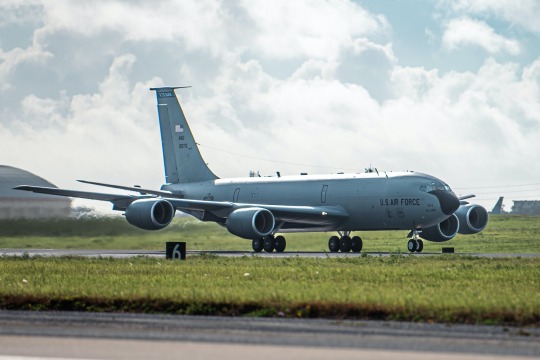
USAF adds Command and Control capability to the KC-135 aircraft
Fernando Valduga By Fernando Valduga 09/28/2023 - 16:00in Military
A Stratotanker KC-135 assigned to the 151ª Air Refueling Wing takes off during exercise Northern Edge 23-2 at Kadena Air Base, Japan. (Photo: U.S. Air Force / Senior Airman Sebastian Romawac)
During the recent Northern Edge 2023 exercise, the KC-135 Stratotanker was equipped with new command and control capabilities, marking a departure from its traditional 50-year function of providing fuel support for military aircraft during operations.
Equipped with the Tanker Intelligent Gateway (TIG) system from Collins Aerospace, an RTX company, the KC-135 demonstrated during this exercise its ability to connect different networks, inside and outside the line of sight. This Smart Gateway uses sensor data to make decisions.
Military sensors are getting smarter, but generating a lot of data. To deal with this, different military devices must be able to share information, even if they have not been designed to work together.

The Raytheon Multi-Program Testbed takes off during the Northern Edge 23-2 exercise at Kadena Air Base, Japan. (Photo: U.S. Air Force / Senior Airman Sebastian Romawac)
To solve this problem, the Intelligent Gateway system transforms disconnected platforms into connectivity access points for data passage. During the Northern Edge, for example, the Intelligent Gateway, combined with a command center and battle space control capability, demonstrated how the KC-135 could serve as a command and control node to conduct battle management and dynamic target selection.
This modified KC-135, provided by the Utah National Air Guard, flew alongside the Multi-Program Testbed, a modified Boeing 727 equipped with advanced sensors from Raytheon (also an RTX company) during the exercise. In this joint operation, the KC-135 transferred target designation data on simulated threats at the tactical boundary, showing its new command and control capabilities.
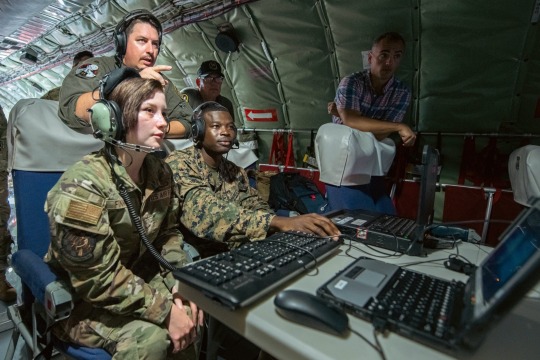
More than 500 OSS air battle managers joined a KC-135 test team to simulate combat and share data during Northern Edge 2023. (Photo: U.S. Air Force / Senior Airman Sebastian Romawac)
Major Mike Starley, director of the test detachment of the KC-135 National Guard National Guard Air Force Reserve Command Test Center, highlighted the importance of this advance, stating: "We have only a certain number of surveillance aircraft available, and in a theater as large as the Indo-Pacific, there will be many areas without command and control. However, we will always have a tanker plane present. Now we can make the most of all this available space and use the KC-135, which is already engaged in combat, for command and control."
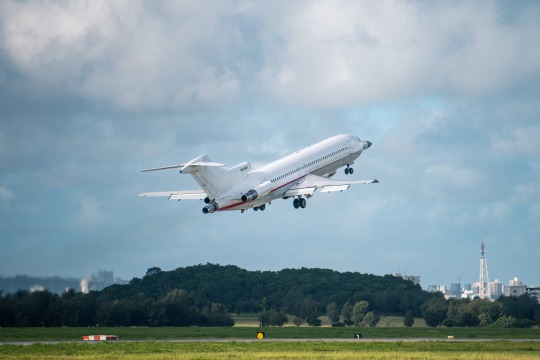
RMT uses a combination of radar and electronic intelligence sensors to capture information about simulated threats that are then passed on to allied players for improved command and control.
The Multi-Program Testbed demonstrated the ability to collect intelligence data from multiple sources, called multi-INT, while demonstrates data synchronization and prioritization using artificial intelligence and machine learning. This simplified data analysis and improved situational awareness for military aircraft.

Intelligent Gateway connectivity combined with the Battlespace Command and Control Center air battle management hardware/software provides command and control capabilities for ABMs conducting a C2 distributed tactical experiment during NE 23-2. (Photo: U.S. Air Force / Senior Airman Sebastian Romawac)
The test platform contained advanced processing software called Nimbus Rush, along with AI-enabled machine-to-machine communications that prioritized multi-INT data and distributed it to various aircraft, including the KC-135 Stratotanker refuel and C-17 and C-130 transport aircraft. These data provided these aircraft with greater awareness of the simulated threats.
Tags: Military AviationBoeing KC-135 StratotankerNorthern EdgeUSAF - United States Air Force / U.S. Air Force
Sharing
tweet
Fernando Valduga
Fernando Valduga
Aviation photographer and pilot since 1992, he has participated in several events and air operations, such as Cruzex, AirVenture, Daytona Airshow and FIDAE. He has work published in specialized aviation magazines in Brazil and abroad. Uses Canon equipment during his photographic work throughout the world of aviation.
Related news
MILITARY
VIDEO: For the first time, BAE Systems/Malloy drone demonstrates torpedo launch
28/09/2023 - 14:00
MILITARY
VIDEOS: Polish Air Force aircraft practice takeoffs and landings on highways
09/28/2023 - 12:00
MILITARY
The German government's VIP transport A350s will receive IR missile self-protection system
09/28/2023 - 10:00
MILITARY
UAC delivers new batches of Su-57 and Su-35 fighters to the Russian Aerospace Forces
09/28/2023 - 08:36
MILITARY
Czech Republic approves purchase of F-35A fighters
27/09/2023 - 22:41
HELICOPTERS
Safran will participate in the U.S. Army FLRAA project
27/09/2023 - 16:00
5 notes
·
View notes